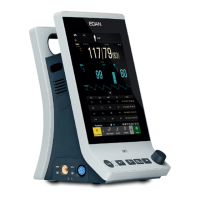Vital Signs Monitor Service Manual System Principle
- 27 -
network, and print functions, with focus on the communication and signal processing functions
between the modules, and the realization of human-computer interaction. The module directly
connected with the main control board includes the button, knob, alarm indicator, 8 inch LCD
screen, touch screen (optional), Micro-SD card, and Wi-Fi (optional), while other modules
communicate with main control board through the parameter transferred board.
6.1.2 Parameter Board
The parameters board is mainly responsible for the power supply management and the
measurement parameters collection; it exports 5V power supply to the main control board, and
simultaneouslycontrolssome module’s power supply. The measured parameters include
noninvasive blood pressure (NIBP), pulse oxygen saturation (SpO
2
), pulse rate (PR), quick
temperature (Quick TEMP) and infrared temperature (Infrared TEMP). The parameter board
controls these monitoring data and communicates with main board after processing.
NIBP
This monitor uses the oscillometric method for measuring NIBP. It inflates the cuff around the
upper arm, until the cuff pressure blocks the brachial artery blood flow, and then gradually
deflates according to a certain algorithm. With the decrease of cuff pressure, the arterial blood
will bring pressure pulsation in the cuff. Through the pressure sensor connecting with cuff
inflating pipe, a voltage fluctuation signal will be generated with pulse beat.
SpO
2
& PR
Based on the pleth of finger pulse, etc., SpO
2
is calibrated through certain algorithm and clinical
data. SpO
2
sensor measures with two built-in luminous diodes and one photocell component. The
two luminous diodes are separately red light and infrared diode, which are light alternately with
certain time order. When hyperemia of the finger capillary occurs repeatedly with the heart pump,
luminous diode light passes through the blood and tissues, and projects onto the photocell.
Photocell can sense the light strength which changes with the pulse blood and whose form is the
changeable optical signals. The ratio of the DC and AC components of the two photoelectric
signals corresponds to the oxygen content in the blood, and the correct oxygen saturation value
can be obtained by a specific algorithm, at the same time, pulse rate can be calculated according
to SpO
2
wave.
Quick TEMP& Infrared TEMP
Quick TEMP uses measurement sensor to measure oral/axillary/rectal temperature. When
measured value is beyond the limit, the monitor will prompt alarm signals; Infrared TEMP uses
infrared detection method to measure ear temperature. iM3 is configured with three temperature
modules including F3000, T2A and TH.
6.1.3 Battery Module
The battery module is mainly responsible for switching AC/DC power. It switches the network
input into +19 V DC power supply to parameter board. The maximum output power is 45W. It
also can charge the battery when parameter board is connected.

